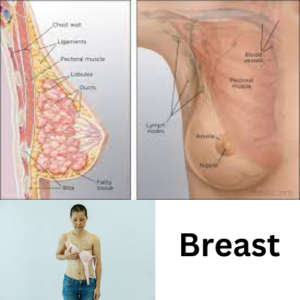The Breast
The Breast
We have described in article :
Introduction to the breast
Breast Extension, Situation, Weight:
Breast Structures Blood supply, Lymphnodes.
Developmental anomalies of breast.

Definition of Breast :
Define : Breast is a term used to describe the mammary gland that is found in mammals, including humans, and is in charge of producing milk for feeding infants. Human breasts are normally found on the chest and are made up of connective tissue, glandular tissue, and fat. Individual differences in breast size and shape are significant, and they can also be influenced by things like pregnancy, hormonal changes, and age. Breasts play a crucial function in nursing, but they are also frequently seen as an essential component of female sexuality and a potential cause of health issues like breast cancer.
Introduction to the breast:
- The breasts are well developed in the female after puberty.
- The breasts are large, Modified sebaceous glands.
- It is compound type of exocrine gland.
- It is also an apocrine gland.
- The breasts areBilateral and in female constitute accessory reproductive organs as the glands are concerned with lactation following childbirth.
- Female sex hormone oestrogen, promote breast development.
Extension : It usually extends from the second to sixth rib in the midclavicular line.
Situation:
- It lies In the subcutaneous tissue over the fascia covering the pectoralis major or even beyond that to lie over the serratus anterior and external oblique.
- A lateral projection of the breast towards the axilla is known as axillary tail of spence. It lies in the axillary fossa, sometimes deep to the deep fascia.
- The breast is separated from the pectoralis fascia by loose areolar tissue called the retromammary space.
Weight: The breast weighs 200-300 gm during the child bearing age.
Structures ( Non-lactating breasts):
A. Skin
- Nipple
- Areola
B. Parenchyma
C. Srtoma
Blood supply of the Breast :
A. Arterial supply:
- Lateral thoracic arteries: Branches of the axillary artery.
- Superior thoracic artery : Branches of the axillary artery.
- Acromiothoracic artery: Branches of the axillary artery.
- Internal thoracic artery: Branches of subclavain artery.
- Posterior intercostal arteries.
B. Venous drainage:
- Superficial veins drains into:
- Internal thoracic vein.
- Superficial veins of the lower part of neck
2. Deep veins drains into :
- Internal thoracic vein
- Axillary thoracic vein
- Posterior intercostal vein.
Lymphatic drainage of breast:
A. Lymphnodes: Drain into the :
Axillary lymph nodes (75%).
- Mainly anterior or pectoral group.
- Posterior, Central and apical nodes also receive lymph from either directly or indirectly .
The internal Mammary nodes (20%).
Also
- Posterior intercostal nodes (5%)
- Supraclavicular nodes.
- Cephalic nodes.
- Subdiaphramatic and subperitoneal lymph nodes.
B.Lymphatic vessels:
- Superficial lymphatics: Skin over the breast except for the nipple and areola.
- Deep lymphatics:
- Parenchyma of the breast.
- Nipple and areola
Nerve supply: The Nerve supply is from fourth, fifth and sixth intercostal nerves.
Development:
- From mammary ridge/milk line/ line of Schultz (ectodermal thickening) which extends from the axilla to the groin and appears during 4th week of intrauterine life.
- The parenchyma of the breast is developed from the ectoderm.
- The connective tissue stroma is from the mesoderm.
- The persisting part of the mammary ridge is converted into a mammary pit.
Developmental anomalies of breast:
- Amestia: Absence of breast.
- Athelia : Absence of nipple.
- Polymastia : Supernumerary breast.
- Polythelia: Supernumerary nipple.
- Gynaecomastia: Development of breast in male.
Witch’s milk: Under influence of maternal oestrogens. The infant breast secrete milk during the first one or two weeks after birth, a fat free fluid, is called

hi!,I love your writing so a lot! proportion we be in contact more about your post on AOL? I require an expert in this area to resolve my problem. May be that is you! Looking forward to see you.
Great post, you have pointed out some excellent points, I too think this s a very good website.
I do trust all the ideas you have introduced for your post. They are very convincing and can certainly work. Still, the posts are too short for novices. May you please prolong them a bit from next time? Thanks for the post.
When I originally commented I clicked the -Notify me when new comments are added- checkbox and now each time a comment is added I get four emails with the same comment. Is there any way you can remove me from that service? Thanks!